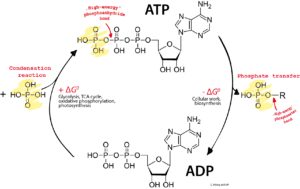An exergonic reaction example is cellular respiration, where glucose (C6H12O6) combines with oxygen (O2) to produce carbon dioxide (CO2), water (H2O), and energy. It releases approximately 686 kilocalories per mole of glucose, illustrating a high-energy yield and entropy increase, characteristic of exergonic reactions.Exergonic reaction example has been listed below:
Exergonic Reaction
Exergonic reaction refers to the idea of chemical reaction which releases a certain amount of negative energy. This reaction comes under the chemical thermodynamics part of chemistry. It is highly conserved with the concept of realising free energies once the reaction is done. The net amount of free energy release indicates that the process is quite spontaneous and happens in a closed system.
However, one condition can be found in this type of chemical reaction that is the initial and final temperature of the system would be same. Generally in a constant temperature a certain amount of Gibbs free energy or Helmholtz energy is required for proceeding with any chemical reaction process.
One of the most important factors that should be understood that is the exergonic reactions do not need energy from outside. Constant temperature is the only criterion for getting the outcomes as the product and the free energies. There are various examples that can be described from in the thermodynamics context of the study.
Cellular Respiration
This is one of the most relevant examples of exergonic reaction which biologically happens in human body. This is basically the chemical reaction which follows the pathway of exergonic reaction. The main reactants in this process are Carbon Dioxide, water, Glucose and oxygen. These are considered as the main substances which react with each other. As a result free energy molecules are released from this reaction simultaneously with the products.
Basically, Cellular respiration involves in the process of extracting free energy molecules on the form of ATP (Adenosine Tri Phosphate) in the human body which stores energy in the cellular organ Mitochondria. Not only in human body can it be happened in every living being. Most of the chemical reaction regarding Cellular respiration process happens in Mitochondria.

All the way it produces energies or calories in constant and normal body temperature without consuming extra heat or energy from the outside so it is considered as the most relevant example of the exergonic reaction. It happens completely by based on the chemical pathway that shows by the exergonic reactions. All the principles of this reaction can be seen as engaged in the cellular respiration process. This internal chemical process is biologically supported and it can be expressed with chemical formula as well.
Chemical Reaction: C6H12O6 +6O2 = 6CO2 + 6H2O + Energy (36-38 molecules of ATP)
The net amount of 36 to 38 ATP are formed and stored in the mitochondria, the actual products in this chemical reaction are water and Carbon Dioxide. These products are released by human being from the body as well. The energy it produces is stored for future use in the body in case of doing any kind of physical work. Nevertheless, this example can be considered as the simplest example of exergonic reaction which is happening each and every moment in the animal body.
Glycolysis
Glycolysis is also considered as a strong and exact example of exergonic reaction. This process is also simple one but in this one the present of catalyst is quite highlighted anyway. The overall process maintains the thermodynamic concept of exergonic reaction.
In this process some energy has been released with the products after a chemical reaction happens between several chemical components. This reaction is a lengthy one which possesses more than two steps. Therefore, the present of catalyst is required here.
It can be seen that the Phosphofructokinase, Hexokinase and pyruvate kinase are the most important three catalysts which positively provides driving force to the chemical reaction. However, Pyruvate and ATP are the final product comes from the breakage of glucose in present of mentioned catalysts.
The release of free energy molecules in a constant temperature proves that these chemical reactions also follow the pathway of exergonic reaction. Though the stored ATP in living beings helps to break the glucose in this process, the formation of extensive amount of free energy makes this process powerful for considering it as an exergonic reaction.

Chemical reaction: The below image could be the best reference top identify the lengthy biochemical process of glycolysis.
This reaction is the oldest example of exergonic reaction. The reaction is quite reliable in following the principles of exergonic reaction.
Read more about 12+ Exothermic Reaction Examples: Detailed Explanations
Fatty Acid catabolism
The breakdown of fatty acid is another biochemical reaction which integrates the idea of exergonic reaction. This process is highly spontaneous and the breakdown of fatty acid releases a certain amount of energy. This is also supported by the biological facts in the human body.
The presence of enzymes boosts up these reactions and makes it grow rapidly in body by producing a large amount of heat and energy. This catabolism of fatty acid also happens in normal body temperature. Therefore,. The temperature is considered as constant in this case as well. Fatty acids are large molecules.
It is very natural that in the breaking process of these molecules gives out a large amount of energy in the place of reaction. The enzymes work here as the valuable catalysts of this reaction. The long chains in fatty acids store the wholesome energy which gets released by the influence of the enzymes. The long chains of fatty acid break sin small chunks of the energy.

It stores more energy than the glucose or sugar molecules. This process spontaneously creates high energy in the body accordingly it releases Carbon Dioxide just as the cellular respiration process. Normally this process happens in the outer membrane of Mitochondria. Catabolism refers to the breakdown process. Therefore, it can be considered as the exergonic reaction. The thermodynamic expression is highlighted in its chemical formula.
Chemical reaction: fatty acid and Coenzyme A reacts in presence of AMP and PPi (forms from ATP breakdown) and gives Fatty acyl coenzyme A and water. The product contains the energy.
Combustion of Propane
This entirely is taken as a chemical example of exergonic reaction without any influence of biological aspects. This reaction can be a practical example by preceding it in artificial way. In the case of chemical reactions this process can be represented as the example of exergonic reaction by creating the environment suitable for exergonic reaction.
In a constant temperature and constant enthalpy Propane molecule reacts with oxygen and breaks into water and Carbon Dioxide and gives out certain amount of energy.
Chemical reaction: 5O2 + C3H8 = 4H2O + 3CO2 + energy
Frequently Asked Questions (FAQ)
Question 1: Can fatty acid metabolism be considered as an exergonic reaction?
Answer:- Fatty acid metabolism requires energy to provide from outside. Therefore, it can be said that this reaction consumes energy does not give out free energy molecules. This is also a chemical reaction but opposite of exergonic reaction. Fatty acid metabolism refers to the synthesis of fatty acid so it cannot be considered as an exergonic reaction.
Question 2: What is the fundamental condition for preceding an exergonic reaction and explain why that condition should be applied in this reaction?
Answer:- The fundamental condition is the constant temperature of the place where the reaction would be proceeded.
This is the fundamental condition as the exergonic reaction does not consume heat from outsides. Therefore, there is no need of changing the temperature of the reaction anyway.
Question 3: Why cellular respiration is highly considered as an example of exergonic reaction?
Answer:- Cellular respiration is considers as the most relevant example of exergonic reaction as it totally works under the fundamental chemical thermodynamic conditions of an exergonic reaction. It happens under constant temperature and enthalpy. It releases free energy that is the negative change in enthalpy happens in cellular respiration.
Question 4: What is the main product obtained from glycolysis process?
Answer:- Pyruvate is the main product that is obtained from Glycolysis process.
Question 5: Why fatty acids are appraised as the great storage of energy?
Answer:- Fatty Acid is a long chain of protein molecules it can be considered as the polymer of protein. Therefore, when it breaks being influenced by the work of enzymes a huge amount of energy released with the products.
Question 5: Give an example of pure chemical exergonic reaction, which can be happened artificially.
Answer:- Combustion of Propane is an example of exergonic reaction which produce negative enthalpy under artificially made circumstances for an exergonic reaction.
Also Read:
- Nucleophilic addition reaction
- Exothermic reaction 3
- Nucleophilic substitution reaction
- Precipitation reaction
- Synthesis reaction example
- How to find redox reaction
- Endothermic reaction
- How to balance redox reaction
- Oxidation reaction example
- Light dependent reaction

Hi…..I am Sarnali Mukherjee, a graduate from the University of Calcutta. I love to teach and share knowledge on chemistry. I have gradually gained interest in article writing since one year ago. I would love to acquire more knowledge on my subject in the future.
Let’s connect through LinkedIn: